Windows 10, Windows 8.1 and Windows 8 come with Client Hyper-V so you can run a supported guest operating system inside a Virtual Machine. Hyper-V is Microsoft's native hypervisor for Windows. It was originally developed for Windows Server 2008 and then ported to Windows client OS. It has improved over time and is present in the latest Windows 10 release as well.
Advertisеment
Note: Only Windows 10 Pro, Enterprise, and Education editions include the Hyper-V virtualization technology.
What is Hyper-V
Hyper-V is Microsoft's very own virtualization solution that allows creating virtual machines on x86-64 systems running Windows. Hyper-V was first released alongside Windows Server 2008, and has been available without additional charge since Windows Server 2012 and Windows 8. Windows 8 was the first Windows client operating system to include hardware virtualization support natively. With Windows 8.1, Hyper-V has got a number of enhancements such as Enhanced Session Mode, enabling high fidelity graphics for connections to VMs using the RDP protocol, and USB redirection which is enabled from the host to VMs. Windows 10 brings further enhancements to the native hypervisor offering, including:
- Hot add and remove for memory and network adapters.
- Windows PowerShell Direct – the ability to run commands inside a virtual machine from the host operating system.
- Linux secure boot - Ubuntu 14.04 and later, and SUSE Linux Enterprise Server 12 OS offerings running on generation 2 virtual machines are now able to boot with the secure boot option enabled.
- Hyper-V Manager Down-level management - Hyper-V manager can manage computers running Hyper-V on Windows Server 2012, Windows Server 2012 R2 and Windows 8.1.
Enhanced Session
Recent versions of Hyper-V include a special feature, "Enhanced session". It provides the following useful options for Virtual Machine Connection sessions:
- Display Configuration
- Audio redirection
- Printer redirection
- Full clipboard support (improved over limited prior-generation clipboard support)
- Smart Card support
- USB Device redirection
- Drive redirection
- Redirection for supported Plug and Play devices
To use them, the guest operating system must have Remote Desktop Services enabled and run Windows Server 2012 R2, Windows Server 2016, Windows 8.1, or Windows 10. Also, your virtual machine must be of generation 2.
Note: See How to Enable and Use Hyper-V in Windows 10
To enable Hyper-V Enhanced Session in Windows 10, do the following.
- Open the Hyper-V Manager from the Start menu. Tip: See How to navigate apps by alphabet in Windows 10 Start menu. It can be found under Windows Administrative Tools > Hyper - V manager.
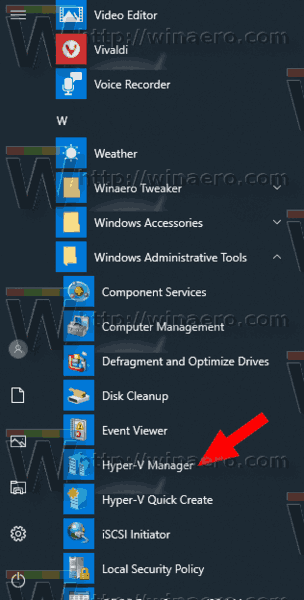
- Click on your host name on the left.
- On the right, click on the link Hyper-V Settings...
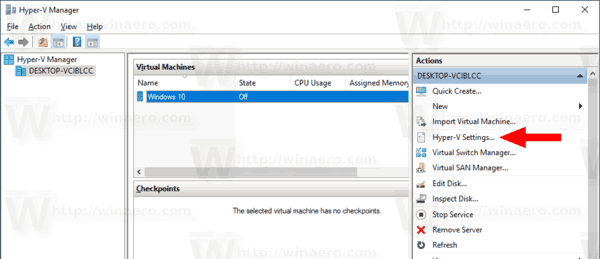
- Click on the Enhanced Session Mode Policy item under Server in the left pane.
- On the right, turn on Allow enhanced session mode on the right.
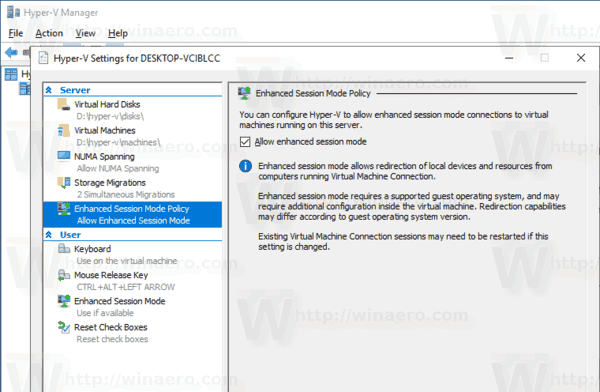
You are done. Note: Turn off the option when you need to disable enhanced session mode.
Alternatively, you can use PowerShell.
Enable or Disable Hyper-V Enhanced Session Mode with PowerShell
- Open PowerShell as Administrator.Tip: You can add "Open PowerShell As Administrator" context menu.
- To see the current status of Hyper-V Enhanced session mode, type or copy-paste the following command:
Get-VMHost | fl -Property EnableEnhancedSessionMode
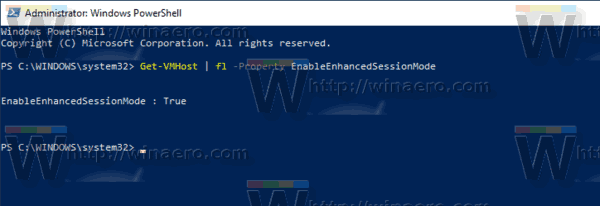
In the output, see the value:
True - the feature is enabled.
False - the feature is disabled. - To enable Hyper-V Enhanced session mode, execute the command:
Set-VMhost -EnableEnhancedSessionMode $True
- To disable Hyper-V Enhanced session mode, execute the command:
Set-VMhost -EnableEnhancedSessionMode $False
Finally, the Enhanced Session mode feature can be enabled or disable for individual machine right from its View menu. See the following screenshot:
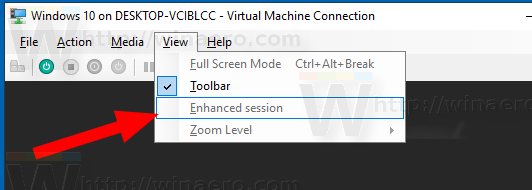
To access this item, start the machine with any guest operating system that supports this feature.
That's it.
Support us
Winaero greatly relies on your support. You can help the site keep bringing you interesting and useful content and software by using these options:

Will you introduce this into your tweaker?
Any reason for that?
It seems that the ‘Enhanced Session’ has no effect on a Ubuntu VM.
I have the ‘Enhanced Session’ box ticked everywhere, but when accessing the Ubuntu VM, then checking the ‘view’ pull down (with the 4 options) the ‘Enhances Session’ is still greyed out.
I’ve done plenty of searching on the web and I think some have got it working for ‘Windows’ Virtual machines.
My setup is: (Host) Windows 10 Pro (Ver: 2004) with Hyper-V enabled, and my Virtual installation is a fresh download of Ubuntu (Ver: ubuntu-20.04.1-desktop-amd64) Downloaded today 16th Aug 2020.
For info, all I wanted to do was have sound pass through to my PC.
@Larry,
Ubuntu’s 20.04 does indeed work with enhanced session mode.
Look at this medium post to show you how: https://medium.com/@francescotonini/how-to-install-ubuntu-20-04-on-hyper-v-with-enhanced-session-b20a269a5fa7
I’m typing this comment in an enhanced session of 20.04.2 in a hyper-v vm on a win10 pro host.